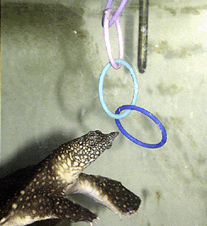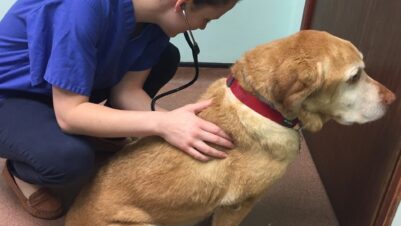
This article acts as a guide to puppy and cat introductions, providing advice on how to prevent chasing and read body language. Many cats may show stress via spraying, urinating out of the litter box and hiding behaviours when they feel unsafe. Stress can compromise both physical and emotional health. So, in these situations, advice can prevent conflict and undue stress.
“How do I stop my dog chasing my cat?”
A popular search on Google is “How do I stop my dog chasing my cat”, with many owners identifying how stressed their cat is due to being chased. Even when puppies are only chasing in play, this can be stressful for cats who have evolved as both predator and prey. Conversely, the author knows of clients whose cats have scratched a dog’s eye in an attempt to bat them away.
Kinsman et al. (2022) discuss how, in an investigation of factors relating to “only desirable” puppy behaviour when introduced to existing household cats, 56.5 percent of cats were reported to have threatened the dog. In the same study, 18 percent of dogs were reported to have threatened the cat.
Preventative advice should be given where possible to avoid problems where clients are considering introducing a puppy into a household with an existing cat
Preventative advice should be given where possible to avoid problems where clients are considering introducing a puppy into a household with an existing cat. If a client will let their trusted vet know that they are planning to get a dog, advice can be given regarding appropriate breed types, traits and what questions to ask a breeder, such as experiences the puppy has had with cats. Also, they can be given, or signposted to, advice on how to best set up introductions, including scent swapping before the puppy even arrives home.
Initial introductions
First impressions matter; an emotionally negative first encounter will make it harder to achieve a harmonious household. The more instances of the dog chasing the cat, the harder it will be to achieve success. But how do we prevent this?
- Scent swapping can help familiarise the cat with the new puppy’s scent. If the breeder or rescue centre is compliant, this can occur prior to the puppy coming home. It involves collecting the puppy’s scent on a clean cloth and letting the cat investigate it in the lead up to the puppy coming home
- Prepare in advance. Both pets should have separate safe spaces that the other pet cannot access. A cat’s resources – including feeding and water bowls, a suitable scratching post, some elevated and hiding spaces, and a litter tray – are key to them, and need to be spaced out in a separate room that the puppy cannot access. The cat should be completely safe from the puppy
- Introduce them over a period of time without meeting face to face.Introductions are recommended to be carried out over days or weeks, depending on the pets’ reactions (Kinsman et al., 2022). Scent swapping should continue during the days in which the puppy is introduced to the home but separated from the cat
- Introduce them through a barrier once the puppy has settled into the home and only if the cat does not show a fearful response to the scent cloth. Meeting behind a baby gate is recommended, but glass doors, Perspex over door frames or any other kind of barrier will work. In the initial barrier introductions, the puppy should be seen but remain a safe distance away from the barrier. Whoever is with the puppy should keep their attention, rather than allow the puppy to run up to the barrier. Have some Lick-E-Lix or other lickable treats on hand to divert the cat further back if they show signs of worry, such as low tucked tails.
- Repeat barrier introductions in short sessions. If both pets remain calm, try to encourage them closer to the barrier over a number of short sessions. Never physically force the animal closer. If you have several sessions where the animals remain calm while being close to the barrier, you can consider sessions without the barrier but with the dog on a lead. During this process, the cat should always have plenty of vertical space and hide options to remove themselves if they get spooked.
Preventing problems
Neurochemically, it can be very rewarding for a dog to chase – and what gets rewarded, gets repeated. Therefore, management is key in these initial stages.
In the first instance, this could be done with a long lead and a pen while the client is training their puppy. Teaching “settle” and “go to your bed” are good things to start with, as well as basic eye contact, such as “watch” or “look at me”. These tools will set the puppy up for success while training, too.
Enrolling into positive, reward-based puppy classes and enlisting the help of a great trainer (like a great vet!) is invaluable. There is also free advice online – Kikopup has a range of great free You Tube videos.
Misconceptions about introductions
Some people may say to let a cat and dog “get on with it” and that a cat will “put a dog in their place”, but this can lead to negative emotions and injury, damaging a relationship before it has even started.
The author does not recommend forcing cats and dogs into a room together – it needs to be a gradual process of introduction. Do not put the cat in a carrier – this can increase the cat’s fear and frustration, as they physically cannot move away, even if they want to. As humans, we are very goal orientated but, instead, we need to focus on how pets are feeling rather than the time it will take to introduce them; their pets’ feelings need to be the main concern for the client. A good analogy to use is a human being able to tell a dentist to stop what they are doing and have a break if it becomes too much (Bleza, 2024).
Body-language red flags
What are the red flags in a cat’s body language? These can be:
- Positioning of the ear in a pixie shape
- Flattened ears, as if they were aeroplane wings
- Dilated pupils
- Nose licking
- Hair standing up on end
- Swishing tails
- Tail tucked underneath the body
Other physical signs of distress can include hiding behaviours; over-grooming around the perineal area, stomach and in between the shoulder blades; changes in eating and drinking habits; hissing; a sudden onset of urinary problems; and becoming increasingly scared.
Red flags in terms of dogs’ behaviour can include (Jones, 2020):
- Charging
- Lunging
- Snapping
- An inability to redirect a dog onto a toy/treat in the cat’s presence
- Intense sniffing under the door of a room the cat is in
To gauge a sense of the pet’s stress, veterinary professionals can elicit open questions such as “Can you tell me about the body language you see in your cat and dog when they are around each other?” Remember that many people believe that a tail wag instantly means a happy dog, even though this is not the case – it’s a sign of arousal. While a tail that moves in a circular motion can indicate happiness, a high, stiff tail that moves slightly from side to side could suggest trouble is ahead. However, fun should not be one sided, of course – a cat will not enjoy being chased.
Enlisting professional help
Despite the best intentions, sometimes challenges can still occur. Enlisting the help of a professional accredited behaviourist is important.
Final thoughts
Having handouts in new puppy packs or client information clinics about cat and dog relationships really helps educate clients.
Despite it being a sign of distress, urinating outside the tray is a huge reason cats are relinquished. With Cats Protection seeing a 30 percent increase in cat abandonment in 2024 (Cats Protection, 2024), providing clients with advice that can lessen, or even prevent, stress when new puppies are introduced into a household with cats can make the world of difference.







